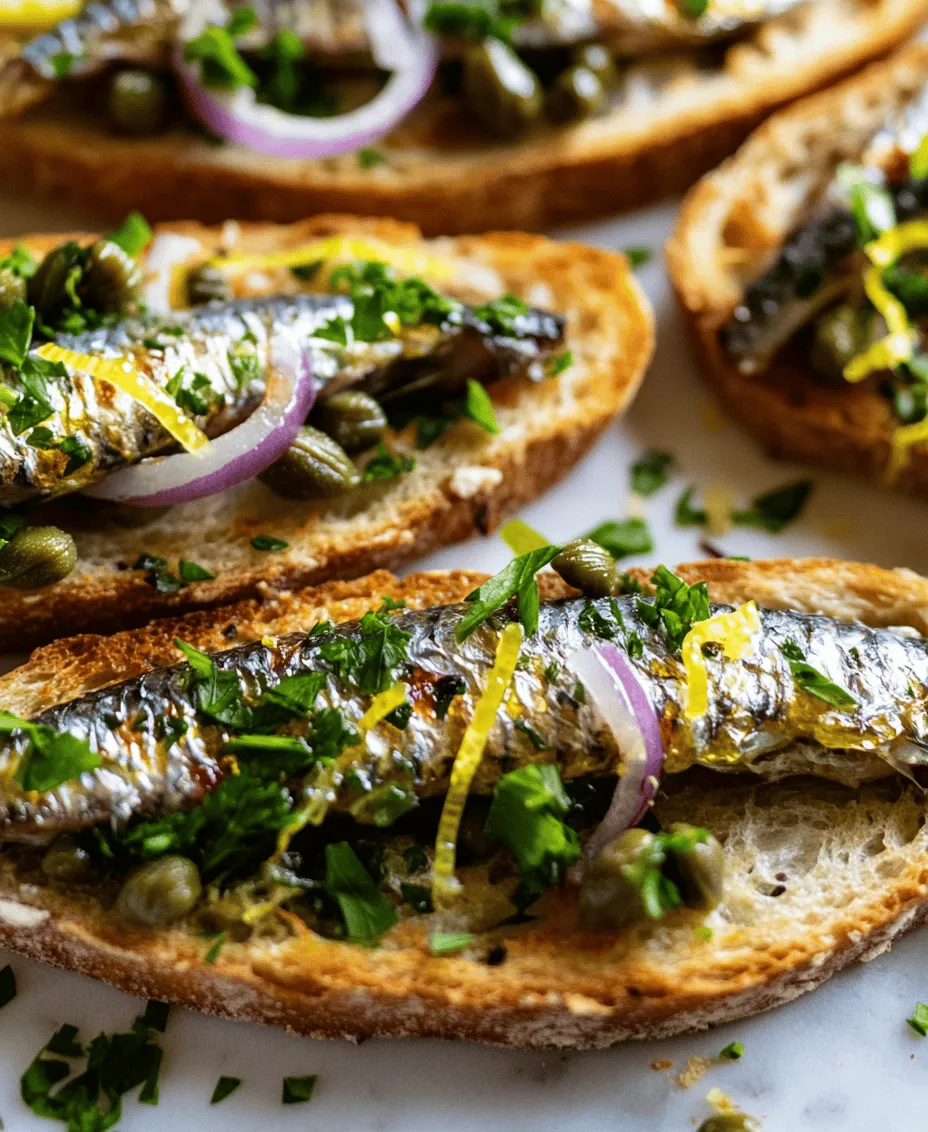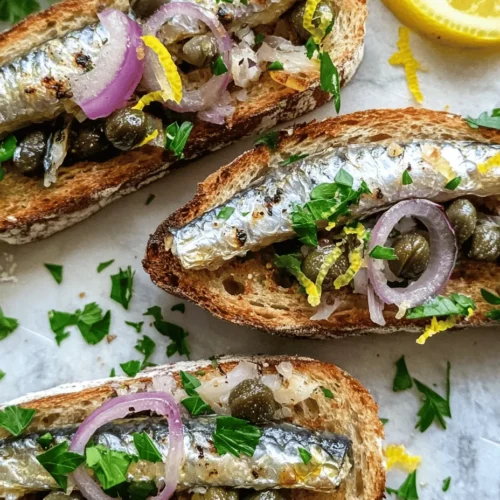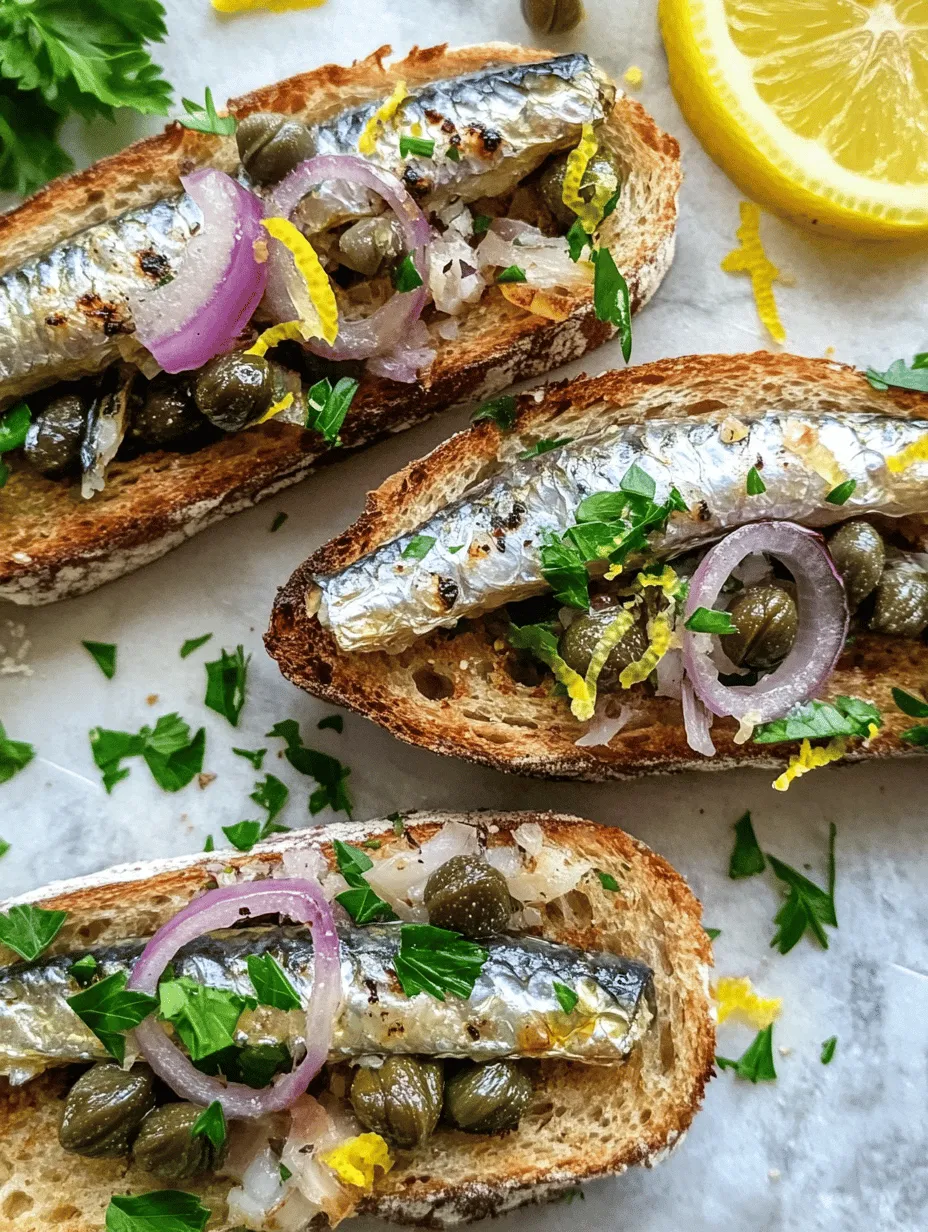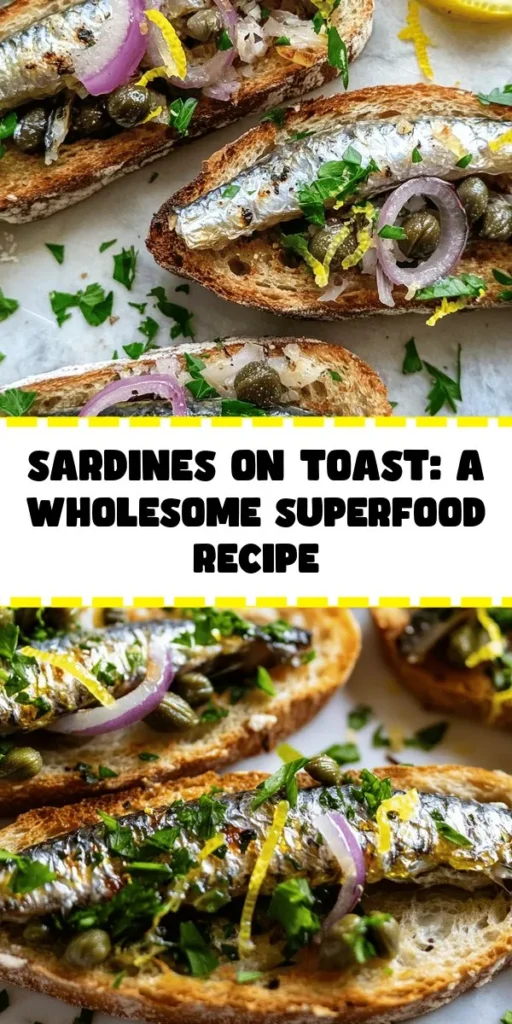Introduction
In recent years, sardines have surged in popularity as a nutrient-dense superfood, capturing the attention of health-conscious food enthusiasts and culinary adventurers alike. These small but mighty fish boast a wealth of nutritional benefits, making them a powerful addition to any diet. Packed with omega-3 fatty acids, protein, and essential vitamins, sardines provide a convenient option for a quick meal that doesn’t compromise on health or flavor.
Alongside sardines, whole grain bread plays a crucial role in creating a balanced diet. Whole grains are known for their high fiber content, which not only supports digestive health but also helps maintain steady energy levels throughout the day. Combining the hearty, nutty flavor of whole grain toast with the rich, savory taste of sardines creates a delightful dish that is both satisfying and nutritious.
This article will guide you through a simple yet delicious recipe for sardines on whole grain toast, perfect for a quick lunch, a light dinner, or even a wholesome snack. By highlighting the benefits of sardines and whole grains, you’ll discover how this dish can elevate your meals while keeping your health in mind.
Understanding the Ingredients
The Superfood Status of Sardines
Sardines are often celebrated as one of the ocean’s most nutritious offerings, and for good reason. These small fish are not only delicious but are also a powerhouse of essential nutrients. They are particularly rich in omega-3 fatty acids, which are known to support heart health and reduce inflammation in the body. Just a small serving of sardines can provide a significant amount of these beneficial fats, along with high-quality protein that is vital for muscle maintenance and overall bodily functions.
Beyond omega-3s and protein, sardines are a great source of important vitamins and minerals, including vitamin B12, selenium, and vitamin D. Vitamin B12 is essential for energy production and neurological function, while selenium plays a crucial role in antioxidant defense and immune function. Furthermore, sardines are an excellent sustainable seafood choice, as they are abundant in many oceans and are typically caught using environmentally friendly methods. This makes them not only a wise nutritional choice but also a responsible one.
The Role of Whole Grain Bread in a Healthy Diet
When it comes to choosing bread for your sardines, opting for whole grain is a decision that supports overall health. Whole grain bread retains all parts of the grain, including the bran, germ, and endosperm, which means it is packed with nutrients and fiber. The fiber content in whole grains is particularly beneficial for digestion, helping to keep you feeling full longer and promoting regular bowel movements.
In contrast, refined bread is stripped of its bran and germ during processing, resulting in a loss of fiber and nutrients. This can lead to rapid spikes in blood sugar levels, which is something many health-conscious individuals strive to avoid. By choosing whole grain bread, you’re not only enhancing the nutritional value of your meal but also contributing to a more balanced diet.
Fresh Ingredients: The Secret to Flavor
To make your sardines on whole grain toast truly exceptional, incorporating fresh ingredients such as onions, capers, and parsley can elevate the dish significantly. Onions provide a sweet and savory depth of flavor, while capers add a delightful briny punch that complements the sardines beautifully. Parsley, with its fresh, herbal notes, brightens the dish and adds a pop of color.
Each of these ingredients offers its own nutritional benefits as well. Onions are rich in antioxidants, capers are low in calories but high in vitamins A and K, and parsley is an excellent source of vitamins C and K, along with other antioxidants. By using fresh ingredients, you not only enhance the flavor profile of your meal but also boost its overall health benefits.
Step-by-Step Guide to Making Sardines on Whole Grain Toast
Preparing the Bread
The first step in creating your sardines on whole grain toast is to prepare the bread. Selecting the right type of whole grain bread is crucial; look for options that list whole grains as the first ingredient and avoid those that contain added sugars or preservatives. Once you have your bread ready, it’s time to toast it.
There are two primary methods for toasting bread: using a toaster or a skillet. Both methods can achieve delicious results, but they offer slightly different textures.
– Toaster: The toaster is the quickest option, providing even browning and a crisp texture. Simply place the slices in the toaster and toast until golden brown, typically about 3-5 minutes, depending on your desired level of crispiness.
– Skillet: Toasting bread in a skillet allows for more control over the browning process. Heat a non-stick skillet over medium heat, add a small amount of olive oil or butter, and place the slices of bread in the skillet. Cook for 2-3 minutes on each side until they are golden brown and crispy.
Achieving the right texture and color is essential for a satisfying bite. The toast should be crispy enough to hold the sardines without becoming soggy, while also providing a warm, comforting base for the flavorful toppings.
Handling Sardines
Once your bread is toasted to perfection, it’s time to handle the sardines. If you’re using canned sardines, it’s important to drain them properly to maintain their integrity. Open the can and gently pour off the excess liquid, taking care not to break the fish apart. Depending on the brand, you may find sardines packed in oil, water, or even sauce. Each type will impart a different flavor to your dish, so choose based on your taste preferences.
Sardines are incredibly versatile and can be used in various dishes beyond just toast. They can be added to salads, pasta, or even incorporated into dips. Their rich flavor pairs well with a variety of ingredients, making them a fantastic pantry staple.
Creating the Mustard Mixture
To enhance the flavors of your sardines, creating a mustard mixture is a crucial step. Dijon mustard is an excellent choice for this recipe, as its tangy and slightly spicy profile complements the richness of the sardines beautifully.
In a small bowl, combine a spoonful of Dijon mustard with a squeeze of fresh lemon juice and a sprinkle of lemon zest. The acidity from the lemon juice not only brightens the dish but also cuts through the richness of the sardines, creating a balanced flavor profile. Mix well until combined, ensuring all ingredients are evenly distributed.
This mustard mixture will serve as the perfect spread for your toasted whole grain bread, providing an additional layer of flavor that brings the entire dish together.
By following these initial steps, you’re well on your way to creating a delicious and nutritious meal featuring sardines on whole grain toast. Stay tuned for the next part of this article, where we will delve deeper into finishing touches and serving suggestions.

Tips for Adjusting Flavors to Personal Preference
When preparing sardines on whole grain toast, the beauty of this dish lies in its adaptability. You can adjust flavors to suit your palate, ensuring every bite is just right for you. Here are several ways to customize your sardine toast:
1. Spice Level: If you enjoy a kick, consider adding a dash of cayenne pepper or red pepper flakes. For those who prefer milder flavors, a sprinkle of smoked paprika adds depth without overwhelming heat.
2. Acidity: A squeeze of fresh lemon juice can brighten the dish, but if you want to experiment, try a splash of balsamic vinegar or a dash of apple cider vinegar for a different tang.
3. Herbs: Fresh herbs can elevate the flavor profile significantly. Consider incorporating dill, parsley, or chives for a burst of freshness. Dried herbs like oregano or thyme can also add a nice touch.
4. Cheese: A thin slice of sharp cheddar or a sprinkle of feta cheese can introduce a creamy and salty element that complements the sardines beautifully.
Assembling the Toast
Once your ingredients are prepared and your flavors adjusted, it’s time to assemble your sardine toast. Start by toasting your whole grain bread until it’s golden brown and crisp. This step is crucial, as a sturdy base will support the toppings without becoming soggy.
1. Spread the Base: Begin by spreading a thin layer of your chosen condiment on the toast. Mustard is a popular choice, but you can also use hummus, avocado, or a light spread of cream cheese for a different flavor base.
2. Layer the Sardines: Next, gently place your sardines on the toast. If using canned sardines, you can drain them beforehand and arrange them neatly. For fresh sardines, grill or pan-fry them lightly, then place them on the toast.
3. Add Toppings: This is where you can get creative. Top your sardines with sliced cucumbers, diced tomatoes, or a sprinkle of red onion for added crunch. Finish with your choice of fresh herbs or a drizzle of olive oil.
Layering Techniques for Optimal Presentation
Presentation can elevate even the simplest meals. When layering your sardine toast, consider these techniques:
– Color Contrast: Use a mix of colorful toppings to create visual interest. The vibrant green of herbs, the red of tomatoes, and the golden brown of toasted bread make for an appealing plate.
– Height and Texture: Create layers of texture by adding crunchy elements, like radishes or pickles, on top of your sardines. This not only enhances the aesthetic but also adds different mouthfeel experiences.
– Garnishing: A final touch of microgreens or edible flowers can make your dish look restaurant-quality while adding nutritional value.
Importance of Timing: Serving Immediately for Best Flavor
Sardines on whole grain toast are best enjoyed fresh. The timing of serving is important to retain the crunch of the toast and the freshness of the ingredients. Once assembled, aim to serve the toast immediately to your guests or enjoy it yourself while the bread is still warm and crisp. If you let it sit too long, the moisture from the toppings can seep into the bread, making it soggy and less enjoyable.
Nutritional Benefits of Sardines on Whole Grain Toast
Sardines on whole grain toast is not just a delicious meal but also a powerhouse of nutrition. Let’s break down the nutritional value of this dish:
Calories, Macronutrients, and Micronutrients Analysis
A typical serving of sardines on whole grain toast (two slices with sardines and toppings) contains approximately:
– Calories: 350-450 (depending on toppings)
– Protein: 25-30 grams
– Fat: 15-20 grams (primarily healthy fats)
– Carbohydrates: 30-35 grams
– Fiber: 6-8 grams
This meal is rich in protein, healthy fats, and fiber, making it a balanced option for breakfast, lunch, or dinner.
Health Benefits Associated with Regular Consumption of Sardines
1. Cardiovascular Health: Sardines are a great source of omega-3 fatty acids, which are known to reduce inflammation and support heart health. Regular consumption can help lower blood pressure and cholesterol levels.
2. Brain Function: The omega-3s in sardines play a crucial role in brain health. They are linked to improved cognitive function and may reduce the risk of neurodegenerative diseases.
3. Bone Health: Sardines are also high in vitamin D and calcium, essential nutrients for maintaining strong bones. Incorporating sardines into your diet can support bone density and overall skeletal health.
Whole Grain Benefits Integrated with Sardines
Whole grains are a vital component of a healthy diet. They are rich in fiber, which aids in digestion and helps maintain a healthy weight. When combined with sardines, the protein and fiber work synergistically to promote satiety and stabilize blood sugar levels, making this dish a fulfilling and nutritious option.
Variations and Customizations
Sardines on whole grain toast can be tailored to suit various tastes and dietary requirements. Here are some ideas for ingredient swaps and enhancements:
– Ingredient Swaps: If sardines aren’t your favorite, try other canned fish like mackerel or tuna. They also provide similar health benefits and flavors.
– Alternative Toppings: Avocado adds creaminess and healthy fats, while fresh tomatoes offer juiciness and acidity. You can also try sliced radishes or pickles for added crunch.
– Gluten-Free Options: For those with gluten sensitivities, opt for gluten-free whole grain bread or even lettuce wraps.
– Flavor Enhancements: Experiment with adding spices or herbs. A sprinkle of dill or a dollop of pesto can transform the dish. Different mustard varieties, such as honey mustard or grainy mustard, can also enhance flavor profiles.
Serving Suggestions and Pairings
To elevate your sardines on whole grain toast experience, consider these beverage and dish pairings:
– Ideal Beverages: A crisp white wine, like Sauvignon Blanc, pairs beautifully with sardines. If you prefer non-alcoholic options, herbal teas such as chamomile or refreshing juices like lemon water can cleanse the palate.
– Complementary Dishes: Serve your sardine toast alongside a light side salad made with mixed greens, cherry tomatoes, and a vinaigrette dressing. This not only enhances the meal’s nutrition but also adds freshness.
– Vegetable Dishes: Roasted or grilled vegetables make a perfect side. Consider zucchini, asparagus, or bell peppers that can be seasoned simply with olive oil, salt, and pepper.
Conclusion
Sardines on whole grain toast is a simple yet nutritious dish that offers numerous health benefits. With its rich protein content, healthy fats, and fiber, it supports heart, brain, and bone health. This versatile meal is easy to customize, making it suitable for various tastes and dietary needs.
Incorporating this recipe into your regular meal planning can lead to healthier eating habits without sacrificing flavor or enjoyment. The simplicity of preparation and the array of flavor combinations ensure that it can be enjoyed for breakfast, lunch, or dinner. So why not give sardines on whole grain toast a try? Your taste buds and your body will thank you.



